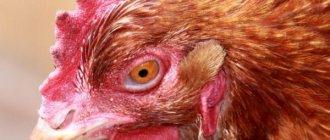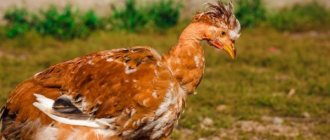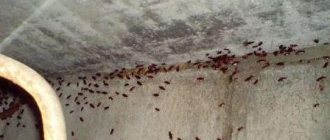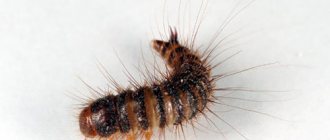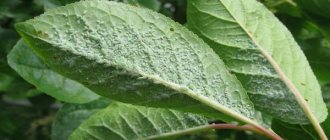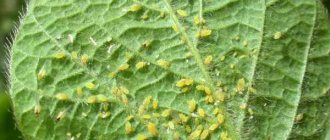Chicken fleas are a type of ectoparasite that feed on the blood of birds. Biologically they differ from their relatives that live on the fur of mammals, but for the owner of poultry these differences are insignificant. Fleas on a chicken look like dog or cat fleas, they jump well and multiply quickly in suitable conditions, populating the poultry house.
Appearance of chicken fleas.
Description and types
The chicken flea has a laterally flattened body, a dense chitinous cover and a developed piercing-sucking mouthparts. The bites are painful and cause itching in the bird.
Fleas are kept on the skin and feathers of chickens due to tenacious paws and numerous outgrowths and hairs. The hind pair of legs is well developed and allows the insect, if necessary, to make jumps of up to 1.5 m. Fleas begin to move in this way when the light levels decrease. During daylight hours, they crawl along the bird’s body closer to its hot skin or feed.
There are mainly 2 types of insects parasitizing poultry:
Appearance of a black flea.
- Chicken flea, Ceratophyllus gallinae. It is brown in color, body length is 2-2.5 mm. It lives on wild and domestic birds, attacks humans and mammals, and affects ornamental and songbirds.
Distributed throughout Europe and Asia.
- Black flea, Ceratophyllus niger. This species is often referred to as the Western chicken flea. Unlike the previous variety, it has a dark body color and a smaller size (1.5 mm).
It lives on different species of domestic and wild birds, and is capable of transferring to humans or mammals.
Ectoparasites have similar development and reproduction cycles and feeding methods. They carry the same diseases, so in the literature for farmers they are most often considered under the general name of chicken fleas.
How do they look
Biologists count thousands of varieties of pigeon fleas. However, these differences are not visible to the naked eye. Parasites are characterized by the following features:
- Dark uniform color.
- Size from 1 to 3 mm.
- On the head there are processes resembling antennae.
- Elongated body shape.
- Three pairs of legs. The third is especially developed. Due to this, the flea can jump long distances.
- There are no wings.
Most often, owners of pigeons encounter fleas.
Features of parasites
The flat body and durable shell protect the insect well from being crushed by the beak or teeth of pets. Fleas are practically invulnerable to birds. By moving and biting the chicken, they make her restless and want to fiddle with her beak in her feathers. This does not lead to the destruction of the insect, and fleas reproduce unhindered.
A parasite dropped on the floor easily returns to the chicken or jumps onto another animal, a person. Can live in the litter until it is time to feed.
As they multiply, the parasites colonize the bird's skin, forming numerous colonies.
Visually, they can be observed in the form of small dark dots on open areas of the skin: most often on the head, near the earrings of chickens, guinea fowl, turkeys, or in the eye area of ducks and geese.
After leaving their host, chicken fleas live on other warm-blooded animals for a short time, but experience discomfort from the insufficiently high body temperature of piglets, humans or smooth-haired animals. This prevents reproduction, and insects move to objects more suitable for them.
The most common places for fleas to accumulate on chickens.
Symptoms of demodicosis
Mites destroy the cells of the follicle walls and sebaceous glands. This leads to the appearance of keratinization, foci of inflammation, and pigmentation. Demodex migrates across the skin, exploring new areas; Thus, with increasing demodicosis, the signs of damage spread over an increasingly larger area. It is also assumed that mites cause sensitization of the body, that is, an allergic reaction is added to mechanical damage.
The main symptoms of demodicosis are:
Acne (acne)
Juvenile acne in most cases is a manifestation of demodicosis.
Skin redness
Redness may be accompanied by swelling of the skin.
Itching
Itching with demodicosis usually intensifies at night, when mite activity increases.
More about the symptom
Skin changes
Progressive demodicosis leads to changes in the skin: roughening, peeling, and the appearance of thickenings similar to scars. In the advanced stage, the skin takes on an earthy color.
Blepharitis
When Demodex affects the eyelashes, signs of blepharitis (inflammation of the ciliary edge of the eyelids) develop: the eyelids begin to itch, turn red, swell, and may stick together. The eyes water, inflammation spreads to the conjunctiva - conjunctivitis develops. Loss of eyelashes is observed.
Where they come from and the life cycle
Fleas can enter a chicken coop on human clothing or cat fur, on bedding materials and food. Parasites reach the intermediate host from the external environment: from wild birds. Both types of chicken fleas are considered common parasites of tits and can be carried by pigeons and other birds living in urban and rural areas.
The life cycle is several months.
During this time, the female flea is capable of producing multiple clutches of eggs (daily). They hatch into legless larvae that resemble worms about 1 mm long. The larvae are able to live in the litter, feeding on organic debris, crawl onto chickens, absorbing the feces of adult insects and dead scales of the epidermis. After 7-14 days, the larvae turn into fleas and begin to reproduce.
Where can you get infected?
The population of pigeons around the world is extremely large, and over time it is only increasing. Therefore, the problem of flea infestation can affect everyone. Parasites enter homes in the following ways:
- Through an unglazed balcony.
- Through the ventilation holes. First of all, residents of the upper floor are at risk, because the favorite nesting place for pigeons is the attic.
- Through contact with the bird. For safety reasons, you should refrain from the temptation to pick up the dove.
- Through excrement, for example on shoes or clothing.
- When visiting tight, enclosed spaces where there are large concentrations of pigeons (caves, grottoes).
Signs of appearance in a bird
The first symptom is expressed in increased nervousness of chickens: they often shake themselves, scratch their heads and necks with their paws, and finger the feathers on their chest and back. As the parasites multiply, other signs of infection appear:
- birds lose weight, growth slows down in broiler chickens;
- adult laying hens reduce egg production or stop laying altogether;
- the bird always looks unkempt, its feathers are ruffled;
- at an advanced stage of the disease, dark spots of ulceration appear on exposed parts of the body.
Upon visual inspection, lifting the feather, you can find brownish or black insects crawling quickly.
Why are chicken fleas dangerous?
Flea reproduction and severe infestation become dangerous to the life and health of domestic birds. The need is due to the ability of parasites to carry infections (brucellosis, salmonellosis, trypanosomiasis), dangerous not only for birds, but also for humans and other inhabitants of the estate or summer cottage.
For the bird
Consequences of chicken fleas.
Constantly living on the chicken’s body and absorbing its blood, highly multiplied parasites cause anemia (anemia) in their prey.
The danger is great not only for young animals: general weakening of the body, decreased immunity and lack of appetite gradually make adult birds vulnerable to infectious and non-infectious diseases.
The lack of hemoglobin in breeding hens also affects the quality of the hatching egg.
By carrying pathogenic microorganisms, chicken fleas increase the risk of infection of a large number of chickens, waterfowl and other farm animals.
For man
When a chicken parasite bites, the following pathogens can enter the human bloodstream:
- encephalitis;
- brucellosis;
- pseudotuberculosis;
- salmonellosis and other dangerous infections.
If microbes of the staphylococcal group get into the scratching areas, there is a possibility of ulcers. Allergy sufferers have a reaction to insect feces.
Fighting chicken fleas is necessary not only for the well-being and increased productivity of feathered pets, but also to preserve the health of adults and children who come into contact with domestic animals.
Fighting methods
Chickens cannot get rid of a large number of parasites on their own. To remove them, you can use different methods of fighting: traditional and modern. All of them are aimed only at destroying parasites.
Chicken coop treatment
Fleas live in the litter, crawl into cracks and can reappear after simple cleaning. At home, winter premises are treated after transferring the birds to the summer barn:
- clear the room of litter;
- spray the selected preparations;
- the treated barn is closed for 8-24 hours, according to the instructions for the pesticide.
The summer premises must be prepared for the transfer of birds in advance. To eliminate the possibility of fleas being introduced into a clean chicken coop, birds are subjected to treatment procedures on the day of moving.
Poultry processing
Infected chickens or other poultry breeds must be treated for parasites. To do this, use drops against fleas for dogs and cats (Bars, Dana, etc.), applying them in the same way as on animals: at the base of the neck, between the shoulder blades, on the back of the neck, where it is difficult for the bird to reach the emulsion with its beak.
For flea protection and treatment, you can call a veterinarian to your home. Injections of the drug Ivermectin and similar products quickly and effectively get rid of skin parasites.
Deltamethrin powder is used to sprinkle the bird's feathers and skin if fleas have already infected laying hens. The powder can be added to ash baths to allow chickens to bathe on their own. To treat domestic birds, Butox or other preparations are used, spraying the solution onto the feathers and down.
Chemicals: review of products
Butox solution for treating chickens.
In modern farms, it is convenient to use aerosols and solutions (emulsions) based on permethrin, karbofos and other toxic substances intended to combat crawling insects, these are:
- a solution of Butox (dilute the contents of the ampoule with water according to the instructions), Tetrix, Cucarachi and other drugs is sprayed with a spray bottle or garden sprayer;
- Deltamethrin is a powdered preparation and is suitable for dusting nesting boxes, floors and other surfaces, chickens or ducks themselves using special equipment;
- Raptor, Kombat, Karbofos, Raid, etc. are ready-made sprays, used according to the instructions on the package (spray all accessible surfaces), it is not recommended to treat poultry.
After spraying toxic chemicals in the chicken coop, the room is closed for a period of several hours to 1-2 days. During this time, most of the parasites will die. Ready-made sprays with permethrin, cypermethrin, deltamethrin (Raid, Raptor, etc.) are especially effective.
Small drops seep into any cracks. They act by penetrating the body of insects and cause their death within a few hours. Low toxicity for warm-blooded animals. The decomposition of the pesticide occurs within 1-4 weeks.
Traditional methods
Treating chicken fleas with Deltamethrin.
Traditional methods of controlling chicken fleas are based on the bird's instinctive behavior in getting rid of any skin parasites. Birds take dust baths, falling out in sand, dry soil, etc.
At home, wood and coal ash are a good remedy. It is poured into flat containers and placed in the poultry house so that the baths are always accessible.
If there is a strong proliferation of parasites in the ash, you can add sulfur powder (buy at a veterinary pharmacy or garden store), Deltamethrin or crushed herbs (wormwood, Persian chamomile, etc.).
Traditional methods include the separate use of medicinal plants.
Application of herbs
The ability of a number of plants to repel fleas has long been appreciated by humans and is used to treat not only dogs and cats, but also poultry. The following can be used in a chicken coop:
- infusions and decoctions of aromatic herbs;
- powder from dried plants;
- alcohol tinctures based on poisonous flora.
Aromatic herbs are used to repel parasites. Their essential oils are unpleasant to fleas, and the parasites quickly leave the house. The following varieties can be used:
- lavender;
- tansy;
- juniper;
- geranium (houseplant);
- rosemary;
- pyrethrum;
- wormwood, etc.
To repel fleas, it is convenient to use powder from these herbs: the dried raw materials are ground and scattered throughout the chicken coop, paying special attention to the nesting boxes. Chickens and their related species do not have a developed sense of smell, and it is impossible to frighten them off with odors, but the larvae and adults of fleas and ticks most often live in the litter of nests.
The powder is also added to ash baths at a ratio of 1:1. A simple bathing procedure for a chicken becomes therapeutic if fleas have already attacked its feathers.
In addition to the dry method, strong decoctions of aromatic raw materials are used to treat the chicken coop. You can brew 3-4 tbsp. l. crushed wormwood, tansy and other herbs, pouring boiling water over the plants. It is most convenient to infuse in a thermos, leaving the liquid overnight. Spray the shed when cleaning using a spray bottle.
Poisonous plants are also used to kill fleas:
- wild rosemary;
- pyrethrum (Persian chamomile);
- hellebore.
These varieties can be infused with vodka by combining 50-70 g of dried raw materials (or about 250 g of fresh herbs) and 0.5 liters of alcohol. Leave for 2 weeks in the dark, after which the medicine can be stored for 2-3 years, using as needed. A warning label must be placed on the container as the liquid is poisonous. Keep out of the reach of children.
If necessary, use the tincture as follows:
- Using a sprayer or swab, apply the drug to the bird’s skin to kill fleas on it;
- spray all surfaces, cracks, corners in the chicken coop, and when keeping cages, treat both the cages and the room;
- remove and burn the bedding from the nest, spray the box and lay down new material.
Options for getting rid of pigeon fleas in an apartment
The first step towards getting rid of fleas in an apartment is to destroy the source of their appearance. If there are nests on a balcony, attic or other place in close proximity to a living space, if possible, they should be destroyed. This is not about killing the birds themselves. You can only get rid of empty nests. The most reasonable option is burning: this way the fleas are most likely to die. The surrounding area must be cleared of feathers, food debris and bird excrement.
The apartment must be completely treated with a special insect repellent. The poison should be sprayed everywhere, even in the most inaccessible places.
It is important to remember that insecticides are dangerous to people and animals. If there are pets at home, they must be removed in advance before pest control.
Immediately after the procedure, you will have to leave your home for a day. And upon your return, do wet cleaning using laundry soap and baking soda.
Preventive actions
To prevent fleas from appearing in the poultry house, methods should be used to repel them and treat ceratophylllosis in the early stages (when chickens can still expel the parasites themselves by bathing in ash). The main carrier of fleas is wild birds, so it is advisable to protect feed and bedding materials in the poultry house from them, and limit the penetration of tits and sparrows into walking yards.
If a new batch of birds is purchased, they can be released into the general flock only after quarantine measures.
During this period, new hens or chicks are kept separately (5-7 days), assessing not only the presence of fleas, lice and other parasites, but also diseases. If ectoparasites are detected during a visual inspection, treatment is carried out with chemicals or folk remedies to destroy them.
Habitat disinfestation
When infested with fleas, both the bird and the habitat (cage) are treated. For this purpose, they choose the same drugs that were used to treat the bird. Completely wash all elements of the cage, food and drinking containers. After this, you will need to take everything out into the fresh air for ventilation (from 3 to 6 hours). Toys and mirrors are thrown away.
During the treatment, the parrot is sent to another home, but pre-treated with soda, manganese or another flea remedy. When treating pigeons, birds are allowed into the dovecote only after 6-8 hours. All bedding, hay and other things are taken out and burned.
